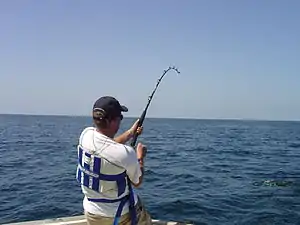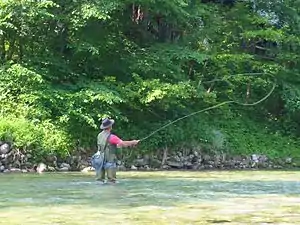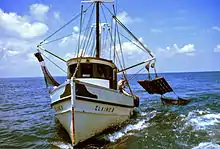Red Tag (artificial fly)
The Red Tag is an artificial fly originally designed as a dry fly for grayling and trout in the north country of England. The fly pattern, when introduced into Australia, particularly Tasmania, became extremely successful and popular for brown trout and remains today as one of the most essential flies for Australian fly anglers.
| Red Tag | |
|---|---|
| Artificial fly | |
 Red Tag (dry) | |
| Type | Dry fly, wet fly |
| History | |
| Creator | Martyn Flynn |
| Created | 1850s |
| Other names | Worcestershire Gem |
| Body | Peacock herl |
| Hackle | Brown cock hackle |
| Tag | Red wool yarn |
| Uses | |
| Primary use | Trout |
| Other uses | Grayling |
Origin
The Red Tag was originally designed by Martyn Flynn from Worcestershire, England in the 1850s as a dry fly for grayling in north country rivers.[1] Its original name was the Worcestershire Gem and was also known as the Worcestershire Wonder.[2]
Materials
The typical Red Tag is tied with a body of peacock herl, a tail of red or crimson wool, and a red cock's hackle (actual color of hack is reddish brown).[3] The hackle can be hen's hackle for wet fly versions. Hook sizes vary from #16 through #10.
Variations

One of the most prevalent variations is the Red Palmer, a wet version of the fly. The Red Palmer uses the same materials but adds a palmered brown hen hackle around the peacock body.[4]
Notes
- "Red Tag-Few flies are as classical as the Red Tag". globalflyfisher.com. Retrieved June 22, 2016.
- Knowles, Christopher (2006). Orange Otter. Ellesmere, Shropshire, UK: The Medlar Press. p. 157. ISBN 9781899600557.
- Nemes, Syvester. "The Fishing Gazette 1877-1966". Two Centuries of Soft-Hackled Flies-A survey of the Literature Complete with Original Patterns 1747-Present. Mechanicsburg, PA: Stackpole Books. p. 60. ISBN 0811700488.
- Herd, Andrew (2012). The History of Fly Fishing, Volume 2, Trout Fly Patterns-1496-1916. Ellesmere, Shropshire, UK: The Medlar Press Limited. p. 188. ISBN 9781907110139.



